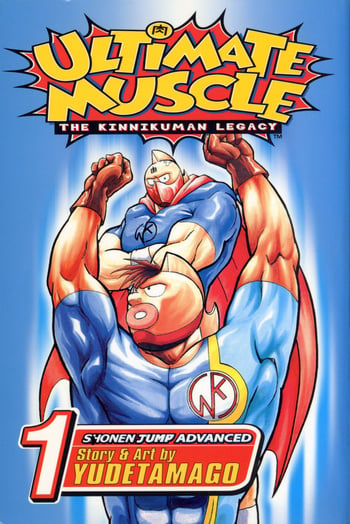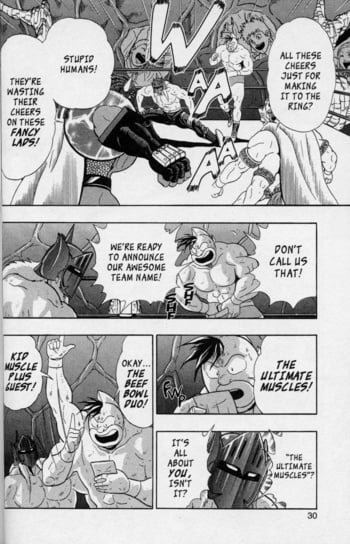Jason Thompson's House of 1000 Manga - Special Guest Edition: Ultimate Muscle
by Shaenon K. Garrity,
If you don't have love in your heart
You can't be a superhero
-Original Kunnikuman theme song
Kid Muscle has the power
He's also kind of nuts
This guy could save the universe
If he only had some guts
-American Ultimate Muscle theme song

When one character in Derek Kirk Kim's graphic novel Same Difference tries to bribe another with her M.U.S.C.L.E. collection—“I'll even throw in the garbage can containers!”—it triggered a wave of nostalgia for me and, I'm sure, many other Gen X nerds. They were always on the toy rack at Big Lots, those packages of weird little pink rubber homunculi. Aside from their wrestling singlets, they seemed to be freaks of some kind, with animal faces, robot bodies, pointy heads. To be honest, I wasn't a M.U.S.C.L.E. collector, gravitating more toward the Battle Beasts. But an air of mystery always hovered around the M.U.S.C.L.E. guys. Were they pro wrestlers? Athletes? Mutants? Monsters? Where did they come from?
Japan, it turns out. The M.U.S.C.L.E. figurines, known in Japan as Kinkeshi, were the sole American extrusion of a 1980s manga/anime/licensing phenomenon. It all started in 1979, when the action-comedy manga Kinnikuman (Muscleman) launched in Shonen Jump magazine. A cross between superhero parody and pro-wrestling goofiness, Kinnikuman followed the misadventures of a greedy, horny, hapless would-be superhero who battled his foes in the ring in battle after outlandish battle. The early chapters parodied the classic tokusatsu show Ultraman, but the series soon moved into the milieu of pro wrestling, which was rising in popularity in Japan just as it was in the U.S.
One of the manga's strokes of genius was to encourage Jump readers to submit their own ideas for characters, which were then incorporated into the story. Among the lucky kids whose wrestlers made it into Kinnikuman was Eiichiro Oda, who much later incorporated his character, Pandaman, into his own hit Shonen Jump manga, One Piece.
Kinnikuman was the brainchild of writer Takashi Shimada and artist Yoshinori Nakai, working together under the name Yudetamago (Boiled Egg). Friends since the fourth grade, they went into the manga business with plenty of enthusiasm and not much artistic experience. In an interview in the back pages of Ultimate Muscle, Shimada recalls that when they moved from Osaka to Tokyo, “Our editor at the time, Shigeo Nishimura, promised to find us jobs if we couldn't make it as manga artists.” But sometimes, in manga, enthusiasm counts for more.
As it turned out, the duo and their editor had nothing to worry about. Kinnikuman was an enormous hit as a manga and even more so as a merchandising juggernaut, inspiring multiple anime series, theatrical movies, over a dozen video games (two of which, M.U.S.C.L.E. Tag Team Match for the NES and Galactic Wrestling for the PS2, have made it to the U.S.), and the Kinkeshi toys, which remain sought-after collectibles in Japan.

The original Kinnikuman hasn't been translated into English, but in 2004 Viz picked up the 2000s sequel series Kinnikuman Nisei, retitled Ultimate Muscle: The Kinnikuman Legacy, to tie in with 4Kids Entertainment's licensing of the anime. The anime died a quick death on American television, but Viz, much to its credit, continued publishing the entire 29-volume manga. (Kinnikuman Nisei ended, but the revived Kinnikuman, retooled with more focus on the original 1980s cast, continues in Japan.)
In Ultimate Muscle, the unwilling superhero is Mantaro “Kid” Muscle, son of Kinnikuman protagonist King Muscle and prince of Planet Muscle. Just as lazy and slovenly as his father was in the original series, Kid Muscle reluctantly sets off to train as a superhero wrestler and, eventually, to defend the Earth from evil. Along the way, he accumulates an array of friends, enemies, and rivals, some of them the offspring of other Kinnikuman characters. It turns out that King Muscle's old ally, the American cowboy Terryman, has a rasslin’ son, Terry Kenyon, and that helmet-clad British powerhouse Robin Mask has sired bad boy Kevin Mask.
As in the original series, the superhuman world is packed with weirdoes: a wrestler who turns into a sneaker, a wrestler who's a walking toilet, a young wrestler with an elderly wrestler growing out of his arm, a wrestler with a microwave in his abdomen, a wrestler who turns into a motorcycle, a wrestler made of Legos, wrestlers shaped like bananas, sushi rolls, photo booths, roller coasters… Also as in the original series, most of these characters come from ideas and sketches submitted by readers.

Ah, but there's a difference. Whereas Kinnikuman ran in Shonen Jump magazine and was written for kids in the 1980s, Ultimate Muscle ran in the adult magazine Weekly Playboy, between the nude photos, and was written for adults who were kids in the 1980s. In other words, it's a nostalgia property, just like G.I. Joe and Transformers comics—and, let's face it, most superhero comics—in the U.S. In Ultimate Muscle, the reader-created characters are credited to guys in their twenties and thirties. In the manga's popularity polls, the old Kinnikuman character Warsman routinely ranks at or near the top, despite not actually appearing in Ultimate Muscle (the creators eventually cave in and write him into the story near the end).
Because it's aimed at adults, Ultimate Muscle can get away with things Kinnikuman couldn't. The original manga indulged in grade-school potty humor, to which Ultimate Muscle adds boobs, boners, and sex jokes. (The Viz translation starts out trying to censor things down to a mild T+ rating but eventually gives up, and by about the halfway point the manga is entirely uncensored.) The violence is more gruesome, too, with limbs and heads ripped off and blood spraying the ring willy-nilly. The mix of slapstick comedy, cheerful tastelessness, melodrama, and graphic gore is jarring—unless you're a fan of pro wrestling, in which case it's comfortably familiar.
Which is not to say there's no plot. Roughly the first third of the series involves a battle between the heroic Muscle League and the evil DMP, whose members wear “DMP” T-shirts suspiciously similar to the shirts worn by the WWF's NWO. With the DMP defeated (…or is it?), Kid Muscle is forced to fight a new series of evil wrestlers, all of them criminals released from superhero prison, to obtain the family power known as the Fire. From there the Muscle League moves on to resurrecting the Superhuman Olympics, a tradition from Kinnikuman. The outcome of the Olympics is decided by reader votes, possibly not a good idea considering nominal hero Kid Muscle's unpopularity in his own manga. (In one popularity poll, Kid Muscle comes in fourth and generates comments like, “I thought if I didn't vote for him, nobody would.”) The final story arc replays another Kinnikuman arc with the rise of a new menace, the Demon Seeds, who kidnap Kid Muscle's sidekick/manager Meat and hide his body parts around Japan.
Ultimate Muscle never quite escapes the shadow of Kinnikuman. No matter what newfangled craziness Yudetamago throws at the page (how about a wrestler…who's a giant cell phone?), it's clear that their fans want the classic Kinnikuman characters and bouts. As a result, the series is sometimes confusing to American readers who haven't been exposed to the older manga.
Which is too bad, because the Yudetamago guys are clearly excited about getting their manga and anime translated into English. The series is peppered with references to the American licensing of Ultimate Muscle, from enthusiastic updates in the author bio pages (“I'd love to see Hollywood make an Ultimate Muscle movie…Jet Li could play Kid Muscle, with the Wachowski brothers directing”) to gags about 4Kids’ decision to erase the iconic kanji from the main characters’ heads. One cover features Kid Muscle sporting an ULTIMATE MUSCLE armband, and later Kid Muscle suggests “the Ultimate Muscles” as a tag-team name for himself and Kevin Mask. Kevin is properly disgusted. “If I had to name one way in which Kid Muscle surpassed his father,” the creators write at the end, “I'd say it was the remarkable accomplishment of Ultimate Muscle making it to the United States.”
In the end, Ultimate Muscle never conquered America, but it's a damn entertaining manga, and kudos to Viz for keeping this oddball title going. I edited all 29 volumes of Ultimate Muscle, and it was some of the most fun I've had as a manga editor. I even tried to convince Derek Kirk Kim to do the lettering. He politely declined. His loss.
discuss this in the forum (21 posts) |